 The new toll “superhighway” was the brainchild of Representative Joseph T. Sayward of Kennebunk and a small group of community leaders who decided the time had come to invest in a modern highway that would provide safe and speedy access to the state’s towns and cities. Up to this point, Route 1, which follows Maine's coast, was the main road between Kittery and Portland and was becoming extremely congested. Some said it would take the better part of a day to travel between the two cities. Studies conducted by the State Highway Department showed that widening or relocating portions of Route 1 was not feasible. However, many worried a new road would direct tourists away from businesses along Route 1. Despite reasonable concerns, Sayward and his group knew how important highway travel would be for Maine, and they pushed on. Plans for the new road went ahead.
The new toll “superhighway” was the brainchild of Representative Joseph T. Sayward of Kennebunk and a small group of community leaders who decided the time had come to invest in a modern highway that would provide safe and speedy access to the state’s towns and cities. Up to this point, Route 1, which follows Maine's coast, was the main road between Kittery and Portland and was becoming extremely congested. Some said it would take the better part of a day to travel between the two cities. Studies conducted by the State Highway Department showed that widening or relocating portions of Route 1 was not feasible. However, many worried a new road would direct tourists away from businesses along Route 1. Despite reasonable concerns, Sayward and his group knew how important highway travel would be for Maine, and they pushed on. Plans for the new road went ahead.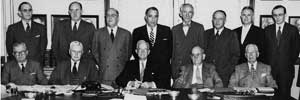 The Maine Turnpike Authority was innovative in its finance method for the road, leveraging funds using revenue bonds for highway construction. More than $20 million was raised through bonds sold to private and institutional investors. This landmark use of revenue bonds allowed for the road to be built without any state or federal funds, and the debt was repaid entirely from projected toll revenues. This unique establishment of revenue bonds produced a national model for how states and municipalities fund major infrastructure projects today.
The Maine Turnpike Authority was innovative in its finance method for the road, leveraging funds using revenue bonds for highway construction. More than $20 million was raised through bonds sold to private and institutional investors. This landmark use of revenue bonds allowed for the road to be built without any state or federal funds, and the debt was repaid entirely from projected toll revenues. This unique establishment of revenue bonds produced a national model for how states and municipalities fund major infrastructure projects today.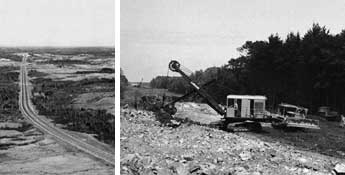 In 1947, when the Authority cut the ribbon on the new road, the Maine Turnpike was the first superhighway built in the postwar era and one of only two modern toll highways in existence in the United States (the Pennsylvania Turnpike opened in 1940). With four wide, clearly marked lanes and a wide grass median, an innovative safety feature at the time, the Maine Turnpike provided a vision of the future of transportation. The highway was straight, swift, safe and efficient.
In 1947, when the Authority cut the ribbon on the new road, the Maine Turnpike was the first superhighway built in the postwar era and one of only two modern toll highways in existence in the United States (the Pennsylvania Turnpike opened in 1940). With four wide, clearly marked lanes and a wide grass median, an innovative safety feature at the time, the Maine Turnpike provided a vision of the future of transportation. The highway was straight, swift, safe and efficient. 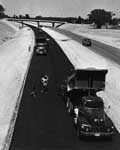 Few people in Maine had ever had the chance to travel at 60 miles per hour. That was why, when the highway opened on a cold day on December 13, 1947, the Portland Press Herald dubbed it the “Mile-A-Minute” highway.
Few people in Maine had ever had the chance to travel at 60 miles per hour. That was why, when the highway opened on a cold day on December 13, 1947, the Portland Press Herald dubbed it the “Mile-A-Minute” highway.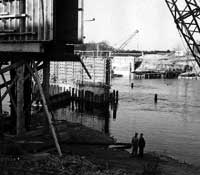 Plans to construct a 66-mile extension of the Maine Turnpike to the state capitol in Augusta, including a four-mile spur to US Route 1 in Falmouth, began very soon after the first section opened. A recommendation from the Maine Good Roads Association in 1949 spurred the State Highway Commission to study the feasibility and potential impact of a Turnpike extension. In April of 1953, the Turnpike Authority issued $75 million in revenue bonds — $55 million to be used for construction.
Plans to construct a 66-mile extension of the Maine Turnpike to the state capitol in Augusta, including a four-mile spur to US Route 1 in Falmouth, began very soon after the first section opened. A recommendation from the Maine Good Roads Association in 1949 spurred the State Highway Commission to study the feasibility and potential impact of a Turnpike extension. In April of 1953, the Turnpike Authority issued $75 million in revenue bonds — $55 million to be used for construction.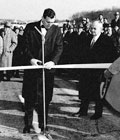 The Turnpike extension was, at the time, the largest highway construction project in Maine history. Two thousand construction workers were employed from the spring of 1954 to the winter of 1955. Twenty million cubic yards of earth, sand and gravel, 145,000 barrels of cement, 350,000 tons of bituminous concrete, 47 million pounds of steel and 11.5 million gallons of asphalt was used to construct the highway extension. Ninety-one bridges were built, including an 846 foot span over the Androscoggin River at Lewiston.
The Turnpike extension was, at the time, the largest highway construction project in Maine history. Two thousand construction workers were employed from the spring of 1954 to the winter of 1955. Twenty million cubic yards of earth, sand and gravel, 145,000 barrels of cement, 350,000 tons of bituminous concrete, 47 million pounds of steel and 11.5 million gallons of asphalt was used to construct the highway extension. Ninety-one bridges were built, including an 846 foot span over the Androscoggin River at Lewiston. In 1956, the first full year after the completion of the highway to Augusta, more than 3,808,382 vehicles used the road. In 2007, the Turnpike’s 60th year, total traffic on the Maine Turnpike had jumped to 63,387,400 vehicles (a 16-fold increase!). Traffic growth was particularly heavy during the late 1960s and early 1970s when, for several consecutive years, the Turnpike’s annual traffic volumes increased nearly 10 percent per year. As traffic volume increased, so did the interest to add more highway capacity to meet the traffic demands.
In 1956, the first full year after the completion of the highway to Augusta, more than 3,808,382 vehicles used the road. In 2007, the Turnpike’s 60th year, total traffic on the Maine Turnpike had jumped to 63,387,400 vehicles (a 16-fold increase!). Traffic growth was particularly heavy during the late 1960s and early 1970s when, for several consecutive years, the Turnpike’s annual traffic volumes increased nearly 10 percent per year. As traffic volume increased, so did the interest to add more highway capacity to meet the traffic demands.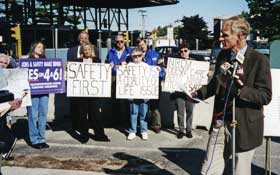 Debate began in the late 1970’s, to decide whether or not the Maine Turnpike should continue as a toll highway or become a “freeway.” Some citizens wanted the responsibility to maintain the roadway and construct new projects on the Turnpike placed under the jurisdiction of the Maine Department of Transportation. In 1982, members of the Maine Legislature passed a bill authorizing continuance of the Turnpike Authority and the tolls to operate the Turnpike, along with provisions to provide a 50 percent discount to regular commuters.
Debate began in the late 1970’s, to decide whether or not the Maine Turnpike should continue as a toll highway or become a “freeway.” Some citizens wanted the responsibility to maintain the roadway and construct new projects on the Turnpike placed under the jurisdiction of the Maine Department of Transportation. In 1982, members of the Maine Legislature passed a bill authorizing continuance of the Turnpike Authority and the tolls to operate the Turnpike, along with provisions to provide a 50 percent discount to regular commuters.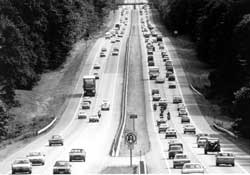 Then state environmental groups began a petition drive forcing a referendum on the widening issue. In 1991, Maine voters stopped the widening project and approved the passage of the Sensible Transportation Policy Act (STPA), which requires an exploration of transportation alternatives to the widening and other state highway projects that might help relieve traffic congestion without the need to construct new projects or expand the existing highway infrastructure.
Then state environmental groups began a petition drive forcing a referendum on the widening issue. In 1991, Maine voters stopped the widening project and approved the passage of the Sensible Transportation Policy Act (STPA), which requires an exploration of transportation alternatives to the widening and other state highway projects that might help relieve traffic congestion without the need to construct new projects or expand the existing highway infrastructure.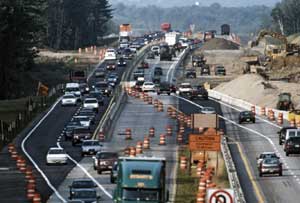 At the conclusion of the study, it was apparent that these alternatives were not enough to reduce traffic congestion on the Turnpike. In 1997, the Authority asked the Legislature to bring the widening question to referendum and Maine voters overwhelmingly favored the project. Nearly 30-years, two state referendums, countless traffic jams and crashes and several in-depth studies had passed. Finally, the Maine Turnpike Authority — and Maine’s citizens — were ready widen the heavily traveled highway.
At the conclusion of the study, it was apparent that these alternatives were not enough to reduce traffic congestion on the Turnpike. In 1997, the Authority asked the Legislature to bring the widening question to referendum and Maine voters overwhelmingly favored the project. Nearly 30-years, two state referendums, countless traffic jams and crashes and several in-depth studies had passed. Finally, the Maine Turnpike Authority — and Maine’s citizens — were ready widen the heavily traveled highway. A cemetery, visible from the Turnpike and located along the highway in Kennebunk, became a landmark for millions of residents and visitors to Maine. The new lane came to within 3 feet of the edge of the cemetery. Many Turnpike travelers wanted to know what, if any, impact the widening would have on this piece of history. The Authority took pains to install guardrail and seasonal chain link fencing during the winter to protect it from snow plowing operations. New granite posts were added where needed, the headstones were treated with a weather proofing material and the general area was spruced up as part of the project. This has enhanced and protected the site to the appreciation of many locals and visitors to Maine.
A cemetery, visible from the Turnpike and located along the highway in Kennebunk, became a landmark for millions of residents and visitors to Maine. The new lane came to within 3 feet of the edge of the cemetery. Many Turnpike travelers wanted to know what, if any, impact the widening would have on this piece of history. The Authority took pains to install guardrail and seasonal chain link fencing during the winter to protect it from snow plowing operations. New granite posts were added where needed, the headstones were treated with a weather proofing material and the general area was spruced up as part of the project. This has enhanced and protected the site to the appreciation of many locals and visitors to Maine.